I still remember the first time I watched a line cook at a gastropub in Portland crush up a bag of Doritos and coat chicken tenders with it back in 2018. My initial reaction was pure skepticism—surely this was some kind of gimmick, right? But one bite changed everything. The nacho cheese powder created this incredible umami depth that traditional breadcrumbs simply couldn’t match, while the corn base delivered a crunch that stayed crispy for hours.
This wasn’t just pub food anymore. This was culinary innovation disguised as comfort food.
Doritos chicken tenders represent something much bigger than a simple recipe hack. They’re a testament to how modern chefs are breaking down the barriers between high-end technique and accessible ingredients. The corn chip coating doesn’t just add crunch—it introduces multiple layers of flavor complexity through MSG, cheese powder, and carefully balanced seasonings that took Frito-Lay food scientists years to perfect.
What makes this dish truly special isn’t just the novelty factor. It’s the way the industrial food science behind Doritos actually enhances fundamental cooking principles. The maltodextrin in the seasoning helps create better browning through the Maillard reaction. The corn base provides superior texture retention compared to traditional breadcrumbs. And the pre-existing salt balance means you’re working with a coating that’s already been precision-engineered for maximum flavor impact.
Ingredients & Substitutions
For the Chicken:
- 2 pounds chicken tenderloins (or chicken breast cut into strips)
- 1 cup all-purpose flour
- 3 large eggs, beaten
- 2 tablespoons buttermilk
- 1 teaspoon garlic powder
- 1/2 teaspoon paprika
- Salt and freshly ground black pepper
For the Doritos Coating:
- 6-7 cups Nacho Cheese Doritos (about 10-11 oz bag)
- 1/2 cup panko breadcrumbs
- 1 tablespoon cornstarch
- 1/2 teaspoon cayenne pepper (optional)
For Frying:
- Vegetable oil or peanut oil for deep frying (about 6-8 cups)
The chicken tenderloin choice here is crucial. While you can absolutely use chicken breast cut into strips, tenderloins have that perfect size-to-thickness ratio that allows for even cooking without overcooking the outside before the inside reaches temperature. If you’re using breast meat, aim for strips that are roughly 3/4 inch thick and 4 inches long.
For dietary restrictions, this recipe can be adapted surprisingly well. Gluten-free Doritos work perfectly if you substitute the all-purpose flour with a gluten-free blend. The key is maintaining that 2:1 ratio of starch to protein in your flour substitute. For those avoiding corn, kettle-cooked potato chips can work, though you’ll lose some of that distinctive umami punch that makes Doritos so effective.
The buttermilk in the egg wash isn’t just for flavor—it’s about chemistry. The acid helps tenderize the chicken while the fat content improves adhesion between the flour layer and the coating. If you don’t have buttermilk, you can substitute with regular milk plus a tablespoon of white vinegar, but the results won’t be quite as tender.
Here’s something most recipes won’t tell you: the specific Doritos flavor matters enormously. Nacho Cheese provides the best balance of umami and salt, but Cool Ranch creates an interesting herbal complexity that works beautifully with chicken. Spicy variants can overwhelm the chicken’s natural flavor unless you’re specifically going for heat-forward preparation.
Step-by-Step Instructions
Preparation Phase:
Start by setting up your breading station properly. This isn’t just about organization—it’s about maintaining the integrity of each coating layer. Use three separate shallow dishes: flour mixture in the first, beaten eggs with buttermilk in the second, and your Doritos mixture in the third.
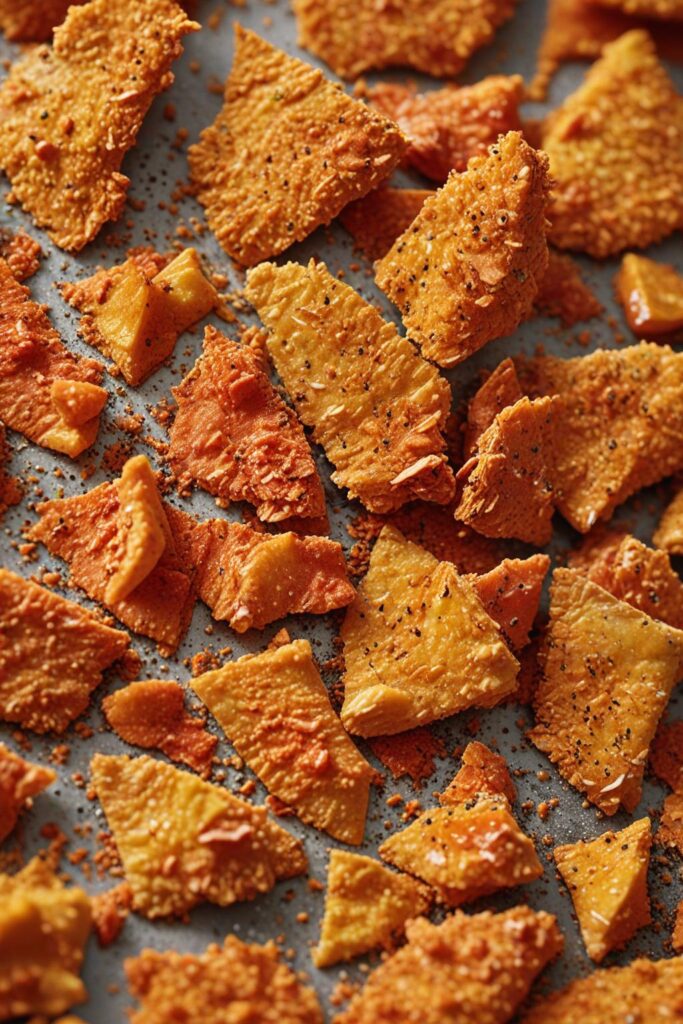
The Doritos crushing technique is where most people go wrong. Don’t just throw them in a food processor and pulverize them into powder. You want varied texture—some fine powder for adhesion, some medium chunks for crunch, and even a few larger pieces for visual interest and surprise texture bursts. Pulse the processor in 2-3 second intervals, checking the consistency after each pulse.
Mix the crushed Doritos with panko breadcrumbs and cornstarch. The panko adds structural integrity that pure Doritos can’t provide, while the cornstarch helps create an even crispier exterior by absorbing moisture during the initial frying phase.
The Coating Process:
Pat the chicken tenderloins completely dry with paper towels. Any surface moisture will prevent proper flour adhesion and create soggy spots in your final coating. Season the chicken lightly with salt and pepper—remember, the Doritos coating is already heavily seasoned.
Dredge each piece first in the seasoned flour, making sure to coat completely but shaking off excess. The flour layer acts as a foundation that helps the egg wash adhere properly. Too much flour creates a gummy texture; too little means poor adhesion.
The egg wash step requires attention to detail. Make sure each piece is completely coated, but let excess drip off for about 3-4 seconds before moving to the Doritos mixture. This prevents the coating from becoming too thick and ensures even browning.
When applying the Doritos coating, press gently but firmly. You want the coating to adhere well without compacting it so much that you lose the airy structure that creates crunch. A light pressing motion works better than aggressive pushing.
Frying Technique:
Heat your oil to exactly 350°F (175°C). This temperature is critical—too low and the coating absorbs oil, too high and the exterior burns before the chicken cooks through. A kitchen thermometer isn’t optional here; it’s essential for consistent results.
Fry in small batches to maintain oil temperature. Overcrowding drops the temperature significantly, leading to greasy, soggy coating. Plan on 3-4 pieces maximum in a standard home fryer or large Dutch oven.
The frying time is typically 3-4 minutes per batch, but don’t rely on time alone. The coating should be deep golden brown, and the internal temperature should reach 165°F (74°C). The Doritos coating will continue browning even after it reaches proper color due to the high sugar content in the cheese powder.
Remove with a slotted spoon and immediately place on a wire rack over a sheet pan. Paper towels might seem logical, but they trap steam and soften the coating. The wire rack allows air circulation that maintains crispiness.
Cooking Techniques & Science
The magic of Doritos chicken tenders lies in understanding the science behind industrial food manufacturing and how it applies to home cooking. Doritos aren’t just seasoned corn chips—they’re precisely engineered flavor delivery systems that happen to work brilliantly as a coating medium.
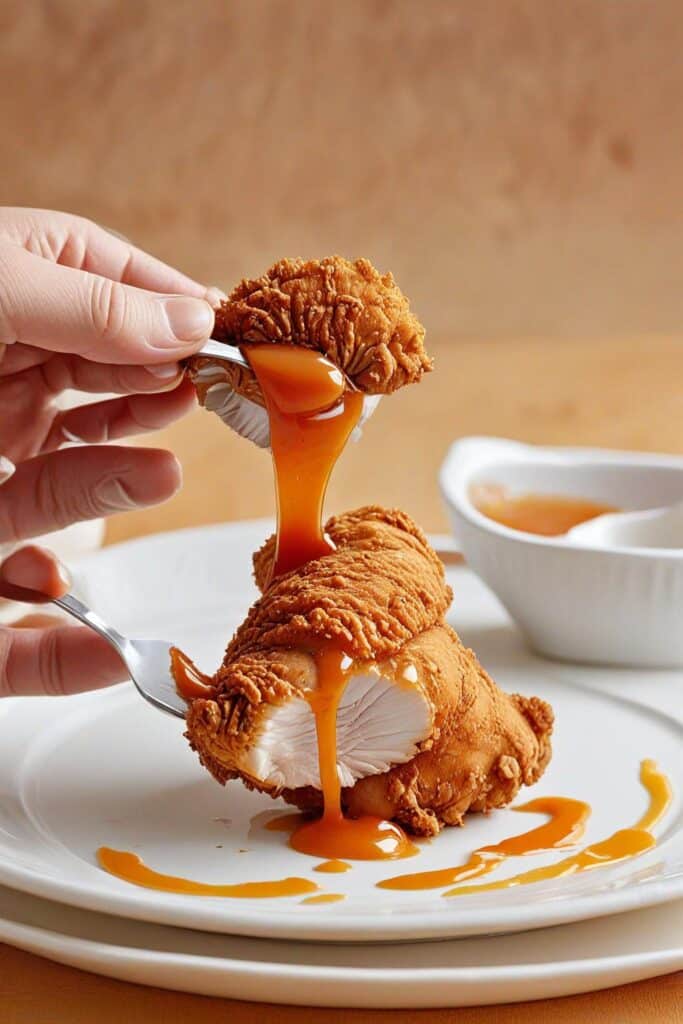
The cheese powder contains several key components that enhance the cooking process. Maltodextrin acts as a browning agent, accelerating Maillard reactions that create that beautiful golden color and complex flavors. The MSG naturally present in the seasoning blend amplifies the chicken’s natural umami compounds, creating a more intense savory experience than traditional breadcrumbs could achieve.
The corn base itself offers superior textural properties compared to wheat-based coatings. Corn has a different protein structure that creates a crispier, more shatter-resistant coating. It also has a higher fat content than breadcrumbs, which helps with heat transfer and creates better browning patterns.
Temperature control during frying becomes even more critical with this coating because of the dairy solids in the cheese powder. These can burn quickly if the oil temperature spikes, creating bitter flavors that overwhelm the dish. Maintaining steady 350°F temperature isn’t just about texture—it’s about flavor preservation.
The double-coating technique (flour, egg, Doritos mixture) creates what food scientists call a “barrier system.” The flour creates a moisture barrier that prevents the chicken’s juices from making the coating soggy. The egg provides protein that coagulates during cooking, forming a secondary barrier. The Doritos mixture provides flavor, texture, and the final moisture barrier.
One fascinating aspect is how the pre-existing salt balance in Doritos eliminates guesswork in seasoning. Traditional breading requires careful salt calibration, but Doritos come pre-seasoned at industrial precision levels. This means more consistent results and less chance of over- or under-seasoning.
Serving & Pairing Suggestions
Presentation matters enormously with Doritos chicken tenders because the visual impact is part of the experience. The vibrant orange-gold coating should be the star, so serve on white or light-colored plates that make the color pop. Arrange pieces with the thickest part facing forward to showcase the coating’s texture.
For plating, consider height and contrast. Stack 2-3 pieces in a slightly overlapping arrangement rather than laying them flat. This creates visual interest and shows off the coating’s dimensional texture. A small ramekin of dipping sauce placed at the 2 o’clock position creates professional-looking composition.
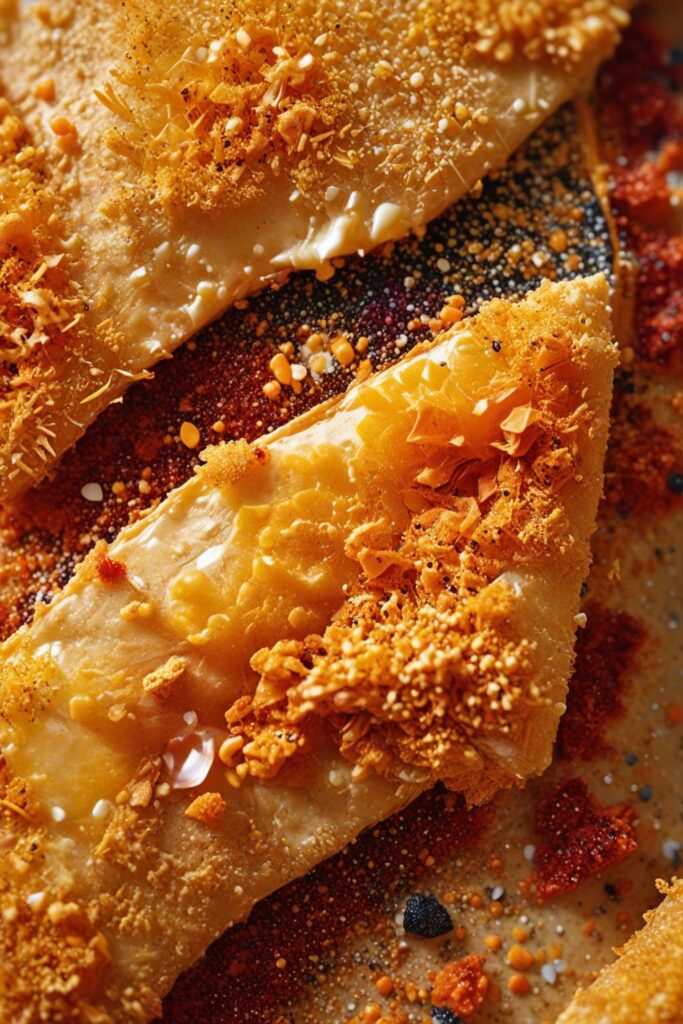
The sauce pairings need to complement rather than compete with the Doritos’ bold flavors. Classic ranch works because its cooling effect balances the cheese powder’s intensity. But consider more adventurous options: sriracha mayo adds heat that plays beautifully with the corn coating, while honey mustard provides sweetness that enhances the cheese flavors.
Side dish selection should provide textural and flavor contrast. Crispy coleslaw adds freshness and crunch variation. Simple steamed vegetables like broccoli or green beans provide color contrast and palate-cleansing properties. Avoid heavy, creamy sides that compete with the rich coating.
For beverages, the high sodium content means you need something that cuts through richness. Cold beer is obvious but effective—the carbonation and hop bitterness balance the cheese flavors perfectly. For non-alcoholic options, lemonade or iced tea provide the acidity needed to refresh the palate between bites.
Consider the temperature serving window carefully. Doritos coating maintains crispiness longer than traditional breadcrumbs, but it’s still best served within 10-15 minutes of frying. If you must hold them, keep them in a 200°F oven on a wire rack rather than under heat lamps, which create condensation.
Advanced Variations and Techniques
The basic Doritos chicken tender recipe is just the starting point for serious culinary exploration. Different Doritos flavors create entirely different dishes. Spicy Sweet Chili Doritos produce tenders with complex heat and sweetness that pairs beautifully with Asian-inspired dipping sauces. Blaze flavor creates an intensely spicy coating that works well for heat lovers.
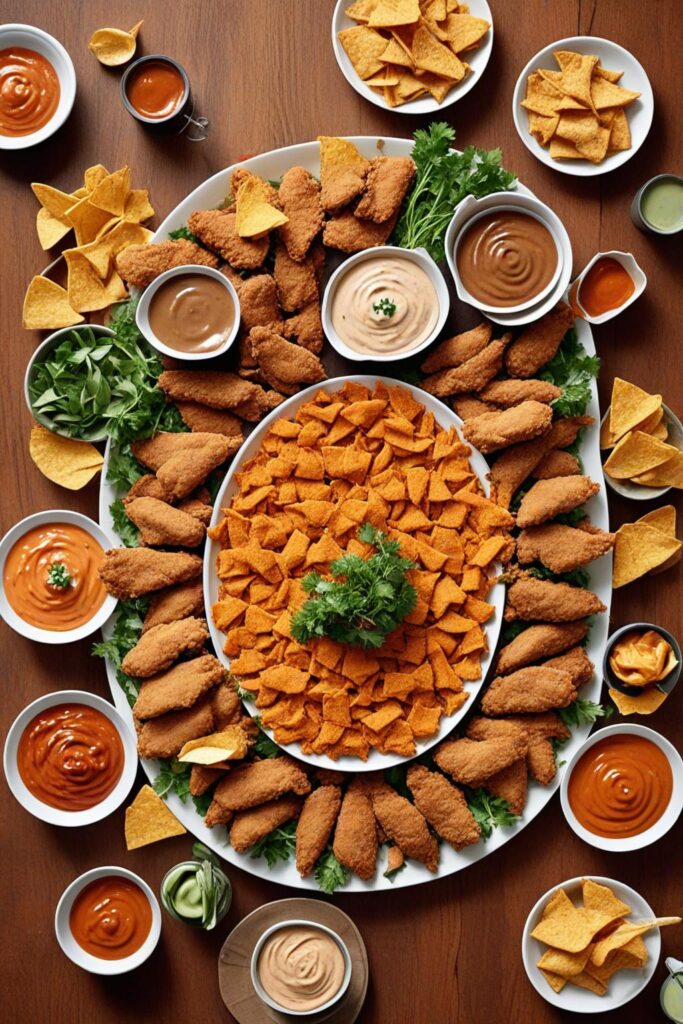
For elevated presentations, consider mixing multiple Doritos flavors in your coating. A 2:1 ratio of Nacho Cheese to Cool Ranch creates interesting flavor complexity without overwhelming the chicken. This technique works particularly well for catering situations where you want to offer something familiar yet unexpected.
The technique adapts beautifully to other proteins. Fish fillets work exceptionally well, particularly firm white fish like cod or halibut. The cooking time reduces to 2-3 minutes, and the corn coating provides excellent moisture retention. Pork tenderloin medallions are another successful application, though they require slightly longer cooking times.
For those interested in baking rather than frying, the technique requires modifications but remains effective. Increase the oven temperature to 425°F and use a wire rack over a sheet pan. Spray the coated chicken lightly with cooking spray to promote browning. The texture won’t be identical to fried versions, but it’s still significantly better than traditional baked chicken coatings.
Restaurant applications benefit from make-ahead techniques. The chicken can be coated up to 4 hours in advance and held in refrigeration. This actually improves adhesion as the coating has time to hydrate slightly from the chicken’s surface moisture. For volume production, par-frying at 325°F for 2 minutes, then finishing at 350°F works well for holding and finishing to order.
Conclusion
Doritos chicken tenders represent something fundamental about modern cooking: the best innovations often come from unexpected combinations of high-quality technique and accessible ingredients. This isn’t about dumbing down cuisine—it’s about recognizing that industrial food science has created tools that home cooks and professional chefs can use to achieve results that weren’t possible with traditional methods alone.
The key to success lies in understanding why this combination works, not just following the steps mechanically. The science behind the Doritos coating, the importance of proper technique in application and frying, and the attention to detail in temperature control all contribute to results that surprise people with their sophistication.
What makes this recipe particularly valuable for professionals is its scalability and consistency. Unlike traditional breading that can vary based on humidity, seasoning precision, and other variables, the Doritos coating provides built-in quality control. This makes it excellent for restaurant applications where consistency is crucial.
The most important takeaway is this: don’t dismiss techniques because they seem unconventional. Some of the most successful dishes in modern cuisine come from chefs who were willing to look beyond traditional ingredient categories and see potential in unexpected places. Doritos chicken tenders prove that innovation doesn’t always require exotic ingredients—sometimes it just requires seeing familiar ingredients in new ways.
Frequently Asked Questions?
Can I make Doritos chicken tenders ahead of time?
Yes, but with important considerations. The coated raw chicken can be prepared up to 4 hours in advance and refrigerated, which actually improves coating adhesion. However, once fried, they’re best served within 15-20 minutes for optimal crispiness. If you must reheat, use a 375°F oven for 3-4 minutes rather than a microwave, which will make the coating soggy.
What’s the best oil temperature and why does it matter so much?
350°F is optimal because it’s hot enough to create immediate crisping and prevent oil absorption, but not so hot that the cheese powder in the Doritos burns before the chicken cooks through. The dairy solids in the coating are particularly sensitive to temperature spikes. Use a thermometer—guessing oil temperature is the fastest way to ruin this dish.
Can I bake these instead of frying?
Absolutely, though the technique requires modification. Bake at 425°F on a wire rack over a sheet pan, and lightly spray the coated chicken with oil to promote browning. The texture will be different—less shatteringly crispy but still much better than traditional baked coatings. Cooking time increases to about 18-22 minutes depending on thickness.
Which Doritos flavors work best for coating?
Nacho Cheese is the gold standard because it provides the best balance of umami, salt, and cheese flavor without overwhelming the chicken. Cool Ranch works well for herb lovers, while Spicy variants should be used carefully as they can overpower the meat. Avoid heavily sweet flavors like Sweet Chili unless you’re specifically creating a fusion dish.
Why do my tenders sometimes turn out soggy even when following the recipe?
The most common causes are: oil temperature too low (absorbs oil), chicken not patted dry before coating (creates steam), overcrowding the fryer (drops oil temperature), or placing finished tenders on paper towels instead of a wire rack (traps steam). Each step in the process affects the final crispiness, so attention to detail throughout is crucial.
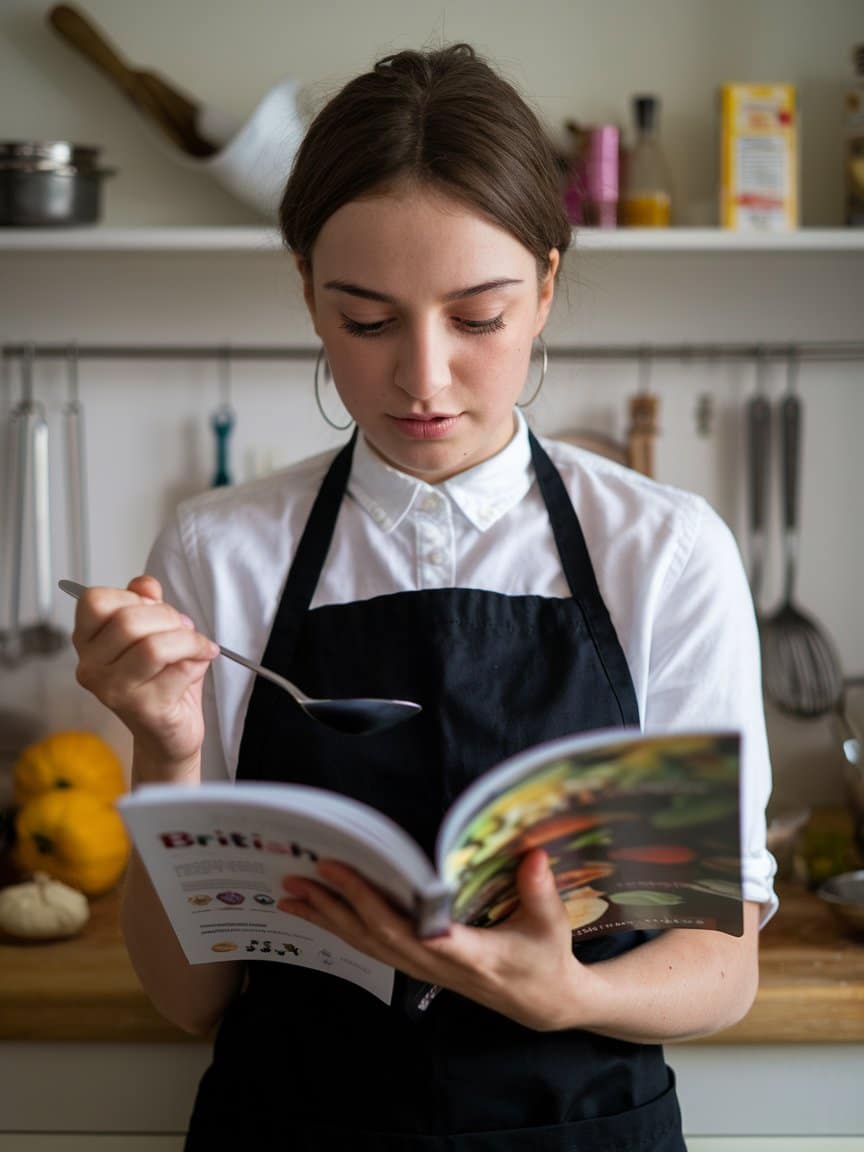
Veronica is a passionate food enthusiast with over three years of experience in exploring and writing about diverse cuisines. Her expertise lies in reviewing restaurants, sharing creative recipes, and discovering the latest food trends. As the voice behind FoodieRecap.com, Anju brings fresh perspectives and culinary insights to her audience.
